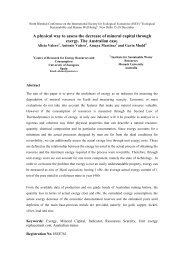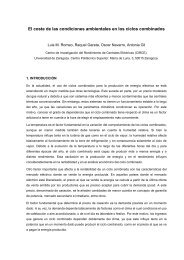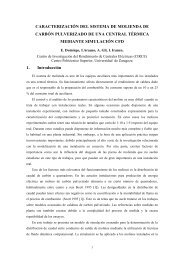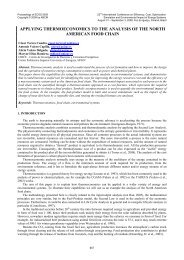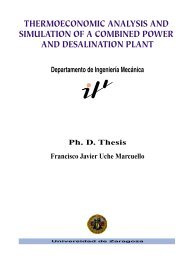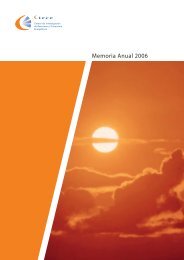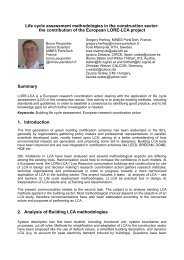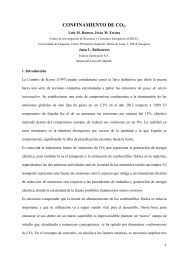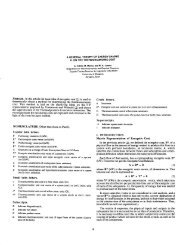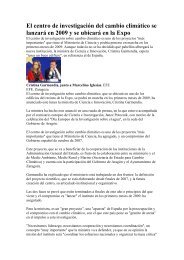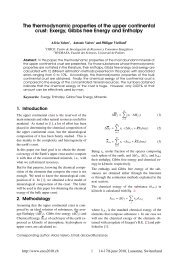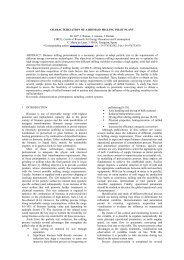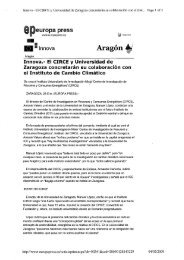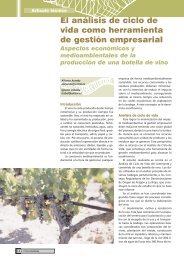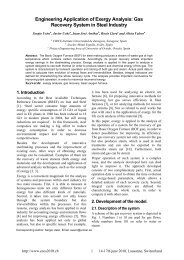towards an international legal reference environment
towards an international legal reference environment
towards an international legal reference environment
You also want an ePaper? Increase the reach of your titles
YUMPU automatically turns print PDFs into web optimized ePapers that Google loves.
calculated basing on the three independent sources<br />
[34], [35] <strong>an</strong>d [36] is estimated as m = 2,93e-2 <strong>an</strong>d is<br />
almost 2,5 times greater. This difference decreases<br />
the chemical exergy of sulfur only about 2 kJ/mol.<br />
The rest of the obtained results are very similar to<br />
previous investigations <strong>an</strong>d the differences are negligible.<br />
Table 3 shows the results obtained in this study for<br />
the chemical exergy of the subst<strong>an</strong>ces dissolved in<br />
seawater.<br />
CONCLUSIONS<br />
A revision of the different R.E. proposed so far has<br />
been done. The authors have agreed to choose as<br />
best suitable R.E. category for the evaluation of natural<br />
capital, a Comprehensive Reference Environment<br />
based on Szargut’s criterion. The parameters<br />
used in the equations for calculating the chemical<br />
exergy of the elements, mainly ∆G, n0, M0, ci, z0i<br />
<strong>an</strong>d m, have been revised <strong>an</strong>d updated according to<br />
new geochemical information <strong>an</strong>d revisions done by<br />
other authors. It has been stated, that the differences<br />
on the chemical exergy of the elements between the<br />
different authors is not very signific<strong>an</strong>t. Therefore,<br />
the current authors would like to propose in ECOS<br />
2005 conference, to take the agreement of accepting<br />
<strong>international</strong>ly the R.E. presented in this paper<br />
for the evaluation of the exergy resources on Earth.<br />
Nevertheless, it has been seen, that this information<br />
c<strong>an</strong> be furthered improved if more empirical updates<br />
appear. Presently, the authors of this paper are working<br />
on improving the data, but other interested authors<br />
are invited to join this research.<br />
REFERENCES<br />
[1] J.M. Naredo. La economía en evolución. Historia<br />
y perspectivas de características básicas<br />
del pensamiento económico. Ediciones Siglo<br />
XXI, Madrid, 1987. In sp<strong>an</strong>ish.<br />
[2] A. Valero, L. R<strong>an</strong>z, <strong>an</strong>d E. Botero. Exergetic<br />
evaluation of natural mineral capital (1) <strong>reference</strong><br />
<strong>environment</strong> <strong>an</strong>d methodology. In Proceedings<br />
of ECOS 2002, Berlin, July 2002.<br />
[3] L. Riekert. The efficiency of energy utilization<br />
in chemical processes. hem. Eng. Sci,<br />
29:1613–1620, 1974.<br />
[4] F. Bosj<strong>an</strong>kovic. Reference level of exergy of<br />
chemically reacting systems. Forschung im Ingenieurwesen,<br />
21:151–152, 1963.<br />
[5] R.A. Gaggioli <strong>an</strong>d P.J. Petit. Second law <strong>an</strong>alysis<br />
for pinpointing the true inneficiencies in final<br />
comversion systems. A.C.S. Division of<br />
Fuel Chemistry, 21(2), 1976.<br />
[6] M.V. Sussm<strong>an</strong>. Choosing a <strong>reference</strong><br />
<strong>environment</strong>-state for available-energy computations.<br />
In 72nd Annual Meeting. Americ<strong>an</strong> Institute<br />
of Chemical Engineers, S<strong>an</strong> Fr<strong>an</strong>cisco<br />
(USA), November 1979.<br />
[7] J. Szargut. Energy potential bal<strong>an</strong>ce in chemical<br />
processes. Archiwum Budowy Maszyn,<br />
4(11):89–117, 1957. In Polish.<br />
[8] J. Ahrendts. The exergy of chemically reacting<br />
systems. Technical report, VDI Forschungsheft<br />
579, Düsseldorf, 1977. In Germ<strong>an</strong>.<br />
[9] C. Diederichsen. Referenzumgebungen zur<br />
berechnung der chemischen exergie. Technical<br />
Report 50, Fortschr.-Ber. VDI Reihe 19,<br />
Düsseldorf: VDI Verlag, 1999.<br />
[10] J. Lovelock. Gaia: A new look at life on Earth.<br />
Oxford University Press, 1979.<br />
[11] H. Kameyama, K. Yoshida, Yamauchi S., <strong>an</strong>d<br />
Fueki K. Evaluation of <strong>reference</strong> exergy for the<br />
elements. Applied Energy, 11:69–83, 1982.<br />
[12] J. Szargut. Chemical exergies of the elements.<br />
Applied Enegy, 32:269–285, 1989.<br />
[13] L. R<strong>an</strong>z. Análisis de los costes exergéticos<br />
de la Riqueza Mineral Terrestre. Su aplicación<br />
para la gestión de la sostenibilidad. PhD thesis,<br />
Universidad de Zaragoza (Spain), September<br />
1999.<br />
[14] R. Rivero <strong>an</strong>d M. Garfias. St<strong>an</strong>dard chemical<br />
exergy updated. part ii. In R. Palido R. Rivero,<br />
L. Monroy <strong>an</strong>d G. Tsatsaronis, editors, Proceedings<br />
of ECOS 2004, pages 773–786, Gu<strong>an</strong>ajuato,<br />
Mexico, 2002.<br />
[15] C.H. Perry, R.H.; Chilton. M<strong>an</strong>ual del Ingeniero<br />
Químico. McGraw-Hill de México,<br />
México, 2nd edition, 1992.



